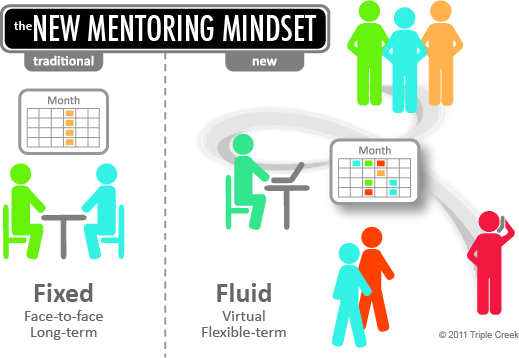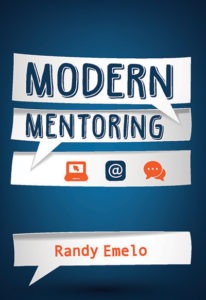Corporate Mentoring Programs Grow Up
In the late 1980s, I was hired to do some executive leadership development consultancy work at a large Fortune 500 company. I remember being on site and walking down a hallway, which was lined with portraits of past company officers and executives, on the way to the executive office area. What struck me as truly rudimentary during my stroll down this hallway was the lack of diversity represented in the portraits. I have to believe that this company has since taken these paintings down, given the fact that all the subjects of these portraits were white males of some experience and maturity. It was this overly homogeneous business environment that prompted business leaders to finally realize that gender diversity was sorely needed in the C-suite. It was with this realization that the practice of corporate mentoring was born. In an effort to promote better gender diversity in leadership, promising young women were matched with and given access to senior executives in an attempt to break the glass ceiling and help female employees rise to executive ranks. Mentoring was administered by HR and limited to only a select female corporate population, which was handpicked to participate. Mentoring, thus, became corporate America’s new way to help women progress more quickly in their careers.
 By the mid ‘90s, the practice of corporate mentoring had gained some additional traction and acceptance, and as a result had become more commonplace. Sponsorship and career progression, the driving forces behind the practice, remained the same. The special audiences invited to participate in mentoring were expanded to include other minorities, besides solely women, and other small populations of high-potential talent. The role of HR in facilitating mentoring was to control and constrain access to senior knowledge assets, providing a now-expanded set of “special” populations access to senior leadership in an effort to help them climb the corporate ladder.
By the mid ‘90s, the practice of corporate mentoring had gained some additional traction and acceptance, and as a result had become more commonplace. Sponsorship and career progression, the driving forces behind the practice, remained the same. The special audiences invited to participate in mentoring were expanded to include other minorities, besides solely women, and other small populations of high-potential talent. The role of HR in facilitating mentoring was to control and constrain access to senior knowledge assets, providing a now-expanded set of “special” populations access to senior leadership in an effort to help them climb the corporate ladder.
Enter the Internet in the early 2000s. This is when we saw the emergence of e-mentoring technologies, which made HR’s job of matching and connecting mentees to mentors easier. This helped corporations expand their mentoring populations once again and increase the size of their high-potential and diversity programs. Still, the purpose and utility of corporate mentoring programs could be summed up in two words: career progression. Additionally, by the mid-2000s, mentoring still only affected 1-5% of an organization.
In 2008, we finally saw a shift in attitude around mentoring and a change in its purpose from career progression to self-directed development and just-in-time performance support. In leading-edge companies, we began to see mentoring expand vertically and horizontally to include non-traditional mentoring relationships. We began to see peers mentor their peers, and Millennial and GenX generations challenge traditional mentoring paradigms by connecting with older mentees and “reverse mentoring” them in areas like technology and social media. We saw people self-organize into group mentoring learning engagements. As a result, enabling technology that supported a more inclusive and dynamic practice was created. Additionally, there were industry thought leaders, like myself, who came out and called for a more modern approach to mentoring and the need to leverage enterprise informal and social learning.
 I am happy to say that this modern mentoring mindset and acceptance of social learning as a powerful learning and development tool has grown substantially in the last few years. That said, there is still a lot of progress that needs to be made. A large majority of HR professionals and business leaders still only see mentoring as a tool for sponsorship and career progression or a practice to be utilized solely in support of targeted formal programs. There will always be a place for traditional mentoring (think mentoring circa 1988-2008) in organizations to serve small organizational populations; in this way, mentoring in its “traditional” sense is not going away. With that being said, the focus now needs to shift to how can we use mentoring, coaching and peer learning practices that have worked for us in the past to develop the other 90-99% of our organization that is not part of a special high-potential or diversity program. Mentoring, like dial-up Internet, needs be modernized to maximize its potential. Modern mentoring is collaborative learning for the masses, and it can be an organization’s tool for developing an agile, connected, future workforce.
I am happy to say that this modern mentoring mindset and acceptance of social learning as a powerful learning and development tool has grown substantially in the last few years. That said, there is still a lot of progress that needs to be made. A large majority of HR professionals and business leaders still only see mentoring as a tool for sponsorship and career progression or a practice to be utilized solely in support of targeted formal programs. There will always be a place for traditional mentoring (think mentoring circa 1988-2008) in organizations to serve small organizational populations; in this way, mentoring in its “traditional” sense is not going away. With that being said, the focus now needs to shift to how can we use mentoring, coaching and peer learning practices that have worked for us in the past to develop the other 90-99% of our organization that is not part of a special high-potential or diversity program. Mentoring, like dial-up Internet, needs be modernized to maximize its potential. Modern mentoring is collaborative learning for the masses, and it can be an organization’s tool for developing an agile, connected, future workforce.
So how can you enable modern mentoring in your organization?
Learn how by downloading this ATD Infoline, “How to Create a Modern Mentoring Culture!”








